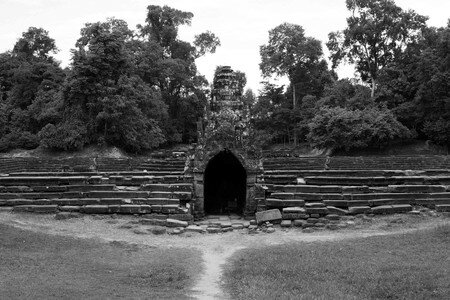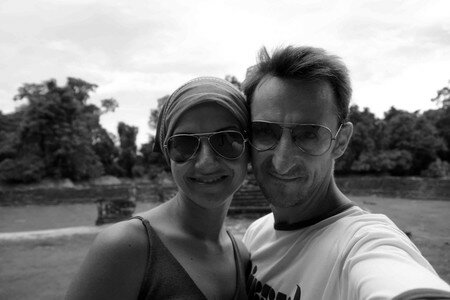Neak Pean
.
Just beyond Krol Ko, the 300 metre route leads to the small island of Neak Pean. This is the “Mebon” of the Prah Khan baray (the “Jayatataka” of the inscription) measuring 3,500 metres by 900 - the two monuments being aligned on the same axis. The island, of 350 metres each side, was defined by a system of laterite steps with pavements set on the axes. Small elephants must once have stood at the four corners since there is still one in place - to the north-east.
King Jayavarman VII placed the “Jayatataka” - the “
The symbolic character of Neak Pean is so established. Already in 1877 Delaporte saw there a building consecrated to the Buddha attaining the glory of Nirvana, with a series of pools cleansing the pilgrims of their sins and lifting them to supreme perfection. In the central basin lies a replica of lake Anavatapta, to be found in the region of the Himalaya at the summit of the world and venerated in India for the healing powers of its waters. It is the source of the four large rivers of the Earth that flow through as many sculpted gargoyles, corresponding to the four cardinal points, which one can also find here with some slight variation.
.
In the middle of the now dry northern baray, Neak Pean itself is but a series of “srahs” (pools) – some with stone surrounds - whose outlines were found within the limits of the laterite enclosure. In plan, a large square pool of 70 metres each side is bordered by steps and has at its centre - surrounded by similar steps - a circular island of 14 metres in diameter on its upper level with a small sanctuary. Four secondary pools of 25 metres each side flank it on the axes, marked by four chapels set into the common surrounding bank.
Two nagas surround the base of the circular island with their tales entwined to the west - from where derives the name Neak Pean. Their heads - separated in order to allow passage to the east - are treated in the manner of the naga Mucilinda which shelters the statues of the Buddha. These are, with their axial head coiffed with a “mukuta”, a representation of the two large Nagarajas - Nanda and Upananda - often associated in Indian literature with lake Anavatapta.
The upper platform appears as the enormous corolla of a lotus blossom, a motif repeated at the base of the prasat by a row of 16 opposing petals, undercut with a groove and particularly pleasing. The Buddhist sanctuary, although the idol had disappeared, has two upper tiers crowned with a lotus and frontons dedicated to the life of the Buddha, - the “Cutting of the Hair” to the east, - the “Grand Departure” to the north, - and Buddha (defaced) meditating under the Bodhi tree to the west - while the southern tympanum has been defaced. The plan is cruciform with an east door – the three others having been walled in and then sculpted with three fine panels containing large images of Lokesvara, the compassionate bodhisattva.
It appears that the sanctuary itself, originally open to the four cardinal points, had its entrance stair enlarged to form a cross - with a banal decoration of devatas - and was rounded by the addition in the inward corners of the three headed elephant which one also finds at the gates of Angkor Thom, but here surmounted with a rearing lion instead of the figure of Indra.
In similar fashion, on the circular island, an earlier system of steps in laterite and sandstone with a perron to the east was covered with the present surfacing, which is ornate and all in sandstone. It is possible that these additions and alterations corresponded to a change in cult or destination. Neak Pean, though dedicated to the Buddha at the time of its construction, would have been avowed to Lokesvara only towards the end of the reign of Jayavarman VII, at the time when the pools were arranged for healing ablution or purification.
Whatever the reason, the ornamentation of the initial prasat – and notably of its pilasters and frontons - places it in that part of the 12th century subsequent to Angkor Wat, while the unity of style and conception of the monument confines it to a limited period.
The four chapels are set into the steps of the central pool just to the base of their frontons, and are all similar. Each is open to the secondary pool, with the line of the opening arch following the full tympanum of the gable end wall. Composed of a continuous nave whose oval formed corbelled vault is decorated internally with lotus coffers and with, at the back, a mid height platform serving as a base for a mascaron gargoyle and a plinth for an idol, each has the external appearance of a groin-vaulted central core, square in plan and surmounted by a pinnacle, which is extended, on its main axis, by two gable ended avant-corps - the whole then flanked laterally on each side by three similar but less dominant projections.
The four buildings served for the ablution of the pilgrims who, to judge by the motifs on the frontons, hoped to be cured of their illnesses or afflictions. Crouched on a circular lotus base bearing the imprint of two bare feet, and thus elevated symbolically above the level of their physical reality, they showered themselves with water flowing from the gargoyle that was fed from the exterior by a channel. This channel terminates at the large pool in a sort of ornamental stone bowl, also in the form of a lotus blossom, surmounted with a feminine bust with her back to the steps, where the officiant would have practised the rites.
The mascaron gargoyles - in the form of an elephant’s head to the north, a horse’s head to the west and lion’s to the south - are mediocre in execution - with the exception of the human head to the east, which is truly a work of real craftsmanship.
.
.
Sculpted images must once have embellished four axial platforms forming redents at the base of the island. Only to the south has it been possible to identify some blocks of lingas in a multiple setting - no doubt part of the “thousand lingas” described in the inscription of Prah Khan - while to the east is the horse Balaha. It is a form taken by Lokesvara, as the saviour of men. Heading towards the sanctuary as if to safety, the flying animal - the major part of whose body is unfortunately missing - carries the merchant Simhala and his companions in misfortune who, hanging to its flanks, are being rescued from their shipwreck on the island of the rakshasis (Ceylon), where the resident ogresses were in the habit of awakening their obliging hosts of the previous night with their gnashing fangs. The group, hanging from the tail of the horse, is remarkable in its composition and craftsmanship.
Until it was damaged by a storm in 1935, the central sanctuary of Neak Pean was crowned by an enormous Ficus, the sacred tree. In an extraordinary arrangement, its overhanging branches gave a haunting charm to the composition of the monument. Having become its living skeleton, it had formed a rigid foundation with the sinews of its roots framing the sculpted panels and overshadowing the water - but in return, however, managing to crumble much of the superstructure and dislodge that which remained.






/http%3A%2F%2Fstorage.canalblog.com%2F65%2F83%2F88988%2F19477867_o.jpg)
/http%3A%2F%2Fstorage.canalblog.com%2F47%2F35%2F88988%2F19477489_o.jpg)
/http%3A%2F%2Fstorage.canalblog.com%2F44%2F87%2F88988%2F19247205_o.jpg)
/http%3A%2F%2Fstorage.canalblog.com%2F35%2F56%2F88988%2F19247076_o.jpg)
/https%3A%2F%2Fstorage.canalblog.com%2F68%2F13%2F88988%2F131346695_o.jpg)
/https%3A%2F%2Fstorage.canalblog.com%2F46%2F43%2F88988%2F47990981_o.jpg)
/https%3A%2F%2Fstorage.canalblog.com%2F34%2F23%2F88988%2F47957389_o.jpg)
/https%3A%2F%2Fstorage.canalblog.com%2F69%2F48%2F88988%2F47956242_o.jpg)
/https%3A%2F%2Fstorage.canalblog.com%2F71%2F12%2F88988%2F21063019_o.jpg)